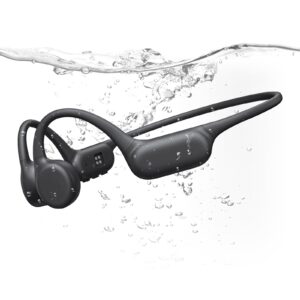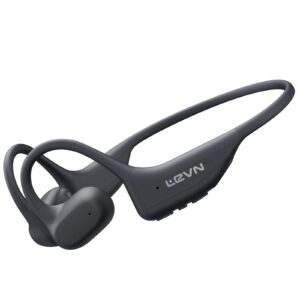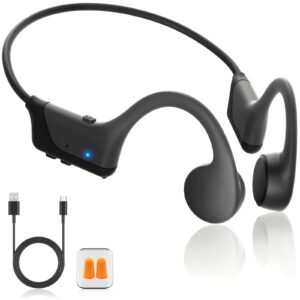We independently select all products and services. If you click through links we provide, Mighty Deals may earn a commission.
For those who experience vertigo, finding the right pair of headphones can make a surprising difference. Whether it’s for enjoying music, managing phone calls, or simply blocking out unwanted noise, the right headphones should provide comfort and stability without exacerbating symptoms. Many traditional headphones may feel too heavy, put pressure on sensitive areas, or fail to maintain balance, making it important to choose models specifically suited to those needs.
When shopping for headphones as someone managing vertigo, it’s essential to pay attention to factors like weight, fit, and design. Over-ear headphones might feel too bulky for some, while in-ear options should provide a snug yet comfortable fit without causing additional strain. Noise-canceling features can also be helpful for reducing external distractions but should be implemented in a way that doesn’t feel disorienting for the user. Materials, adjustability, and long-term wearability are also crucial to ensuring a positive experience.
We researched and tested a range of headphones to identify the ones that are lightweight, stable, and comfortable enough for anyone living with vertigo.
Best Headphones for Vertigo
We’ve carefully selected the top headphones that offer comfort and stability for those dealing with vertigo.
1. PSIER Bone Conduction Swimming Headphones
These headphones are ideal for swimmers and active individuals who value comfort and versatility.
Pros
- Comfortable open-ear design that doesn’t irritate over long periods.
- Reliable waterproofing for swimming and outdoor activities.
- Convenient MP3 mode eliminates the need to carry a separate device.
Cons
- Sound quality may feel less immersive compared to traditional headphones.
- Limited to about 8 hours of battery life, which might not suit long trips.
- Magnetic charging could feel less convenient for those used to standard cables.
We found the open-ear design incredibly comfortable, even when wearing it during long workouts. It keeps us aware of our surroundings, making it ideal for spaces where safety is a priority. The soft silicone cushions sit lightly on the ears, and the adjustable strap makes it easy to achieve a secure fit.
The waterproof rating makes these headphones a standout choice for swimming. Whether navigating laps or taking a quick dive, they held up well underwater. Switching to MP3 mode means we can leave our phone behind, which is especially liberating when swimming or running.
However, while the bone conduction technology delivers clear audio, it doesn’t match the depth you’d get from higher-end headphones. That said, the overall listening experience is solid for workouts and daily routines. It’s worth considering if you prioritize convenience and durability over studio-level sound.
2. LEVN Open-Ear Running Headphones
A fantastic option for anyone seeking lightweight, comfortable, and practical headphones that keep you aware of your surroundings.
Pros
- The open-ear design keeps things breathable and reduces ear fatigue.
- Lightweight and comfortable for long-term wear.
- Excellent battery life for extended use.
Cons
- Sound quality might lack depth compared to over-ear models.
- Limited noise isolation may not be ideal for noisy environments.
- Fit may feel less secure for more vigorous activities.
The open-ear design of the LEVN headphones is great for outdoor use. We could enjoy our music while staying aware of our surroundings, which is ideal for running or cycling. The lightweight, soft silicone frame made them easy to wear for hours without any discomfort.
The sound quality is crisp and clear, perfect for casual listening. While it might not match the depth of traditional in-ear headphones, it delivers a natural listening experience that’s very enjoyable. Pairing with devices was quick and seamless, and having the multipoint connection option was super convenient for managing calls and music from different gadgets.
The battery life is impressive, lasting well beyond our workout and even through a busy workday. However, if you’re in a noisy place, the lack of noise isolation could be distracting. But overall, these headphones cater perfectly to those who want functionality, awareness, and comfort.
3. Sungdogin Bone Conduction Headphones
These headphones are a smart option for anyone seeking comfort, safety, and solid performance during daily activities or workouts.
Pros
- Keeps you aware of your surroundings thanks to the open-ear design.
- Lightweight and flexible for all-day comfort, even during intense activities.
- Lasts up to 12 hours on a single charge, perfect for long days.
Cons
- May not deliver the deep bass that audiophiles prefer.
- Waterproofing is limited to IP55, so not fully suited for heavy rain.
- Fit may take some getting used to for new bone conduction users.
We found the Sungdogin Bone Conduction Headphones to be a great balance of innovation and practicality. Unlike traditional headphones, they let you stay aware of what’s around you. Whether you’re jogging in a busy park or multitasking at home, this feature adds a layer of safety we really appreciated.
Their lightweight titanium frame makes them nearly unnoticeable during use. They stretch and bend easily without losing their shape, so they’re extremely durable despite weighing just 29 grams. We used them during a morning hike, and they didn’t slip or feel uncomfortable, even after hours outdoors.
Battery life is exceptional, lasting up to 12 hours on one charge. We comfortably used them for a full workday, followed by an evening walk without needing to recharge. The quick Type-C charging is a bonus; it’s ready to go again in no time. However, if you’re a fan of heavy bass tones, the sound quality might not feel as rich. Still, these shine for casual listening and hands-free calls.
Buying Guide
When selecting headphones for vertigo, we need to focus on features that prioritize comfort, stability, and sound quality while minimizing triggers that could cause dizziness.
1. Lightweight Design
Headphones should be lightweight and comfortable. Heavy models may put unnecessary pressure on the head, which can exacerbate vertigo symptoms. Look for models with minimal weight and soft ear padding.
2. Adjustable Fit
A secure and adjustable fit is essential. Headphones that feel too tight or press into sensitive areas can lead to discomfort. Adjustable headbands and swiveling ear cups help us find the right fit.
3. Active Noise Cancellation (ANC)
Noise-canceling features can help reduce environmental sounds that might contribute to imbalance or disorientation. However, some people with vertigo may find ANC uncomfortable, so this is something to test personally.
4. Open-Back vs. Closed-Back
Closed-back headphones block outside noise but might build up pressure. Open-back designs allow air and sound to pass through, which might feel more natural for those sensitive to auditory disturbances.
5. Low Latency & Consistent Audio Quality
Avoid headphones with audio delays or inconsistent sound, as these can disrupt focus and exacerbate vertigo. Balanced audio without overpowering bass is often more comfortable for extended use.
| Feature | Why It Matters |
|---|---|
| Lightweight Design | Reduces pressure on the head or neck |
| Adjustable Fit | Ensures tailored comfort for long wear |
| Active Noise Cancellation | Helps with external distractions |
| Open-Back Design | Allows a more natural listening experience |
| Consistent Sound Quality | Prevents disorientation due to poor audio |
By focusing on these features, we can target headphones that offer comfort and reduce the risk of triggering vertigo symptoms.
Frequently Asked Questions
When choosing headphones for individuals prone to vertigo, it’s essential to focus on options designed to minimize triggers. Factors like comfort, sound quality, and specific headphone types play a significant role in managing symptoms effectively.
What features should I look for in headphones to avoid aggravating vertigo symptoms?
Comfort is crucial, so lightweight designs and soft ear cushions are ideal. Adjustable headbands help fit the headphones securely without adding pressure. Opt for balanced audio settings to prevent overwhelming sound output, which might trigger symptoms.
Can noise-cancelling headphones relieve vertigo-related discomfort?
Active noise-cancelling headphones can reduce external noise and distractions, potentially decreasing stress and discomfort. However, some people might find the change in ambient pressure caused by advanced noise cancellation unsettling, so personal preference matters.
How do bone conduction headphones work in relation to vertigo prevention?
Bone conduction headphones bypass the outer and middle ear by sending vibrations directly to the inner ear through the bones. This design keeps the ear canal open, which can lessen sensations like fullness or pressure that sometimes worsen vertigo.
Are there specific types of headphones recommended for individuals with vertigo?
Over-ear headphones with proper cushioning and bone conduction models are often considered useful. Open-back designs also allow airflow and avoid a fully enclosed feeling, which can help some users. Personal comfort and sensitivity should guide the selection.
What are open-ear headphones and are they suitable for users prone to vertigo?
Open-ear headphones rest outside the ear and leave the canal unobstructed. By allowing external sounds to mix naturally with audio output, they can reduce the sense of isolation that closed designs sometimes create, making them more comfortable for certain users.
How can headphones affect inner ear balance and contribute to vertigo?
Prolonged use of heavy or tightly sealed headphones might impact inner ear pressure. Loud volumes and certain frequencies can also overstimulate the auditory system, potentially disrupting balance in sensitive individuals. We recommend mindful use to avoid these effects.




